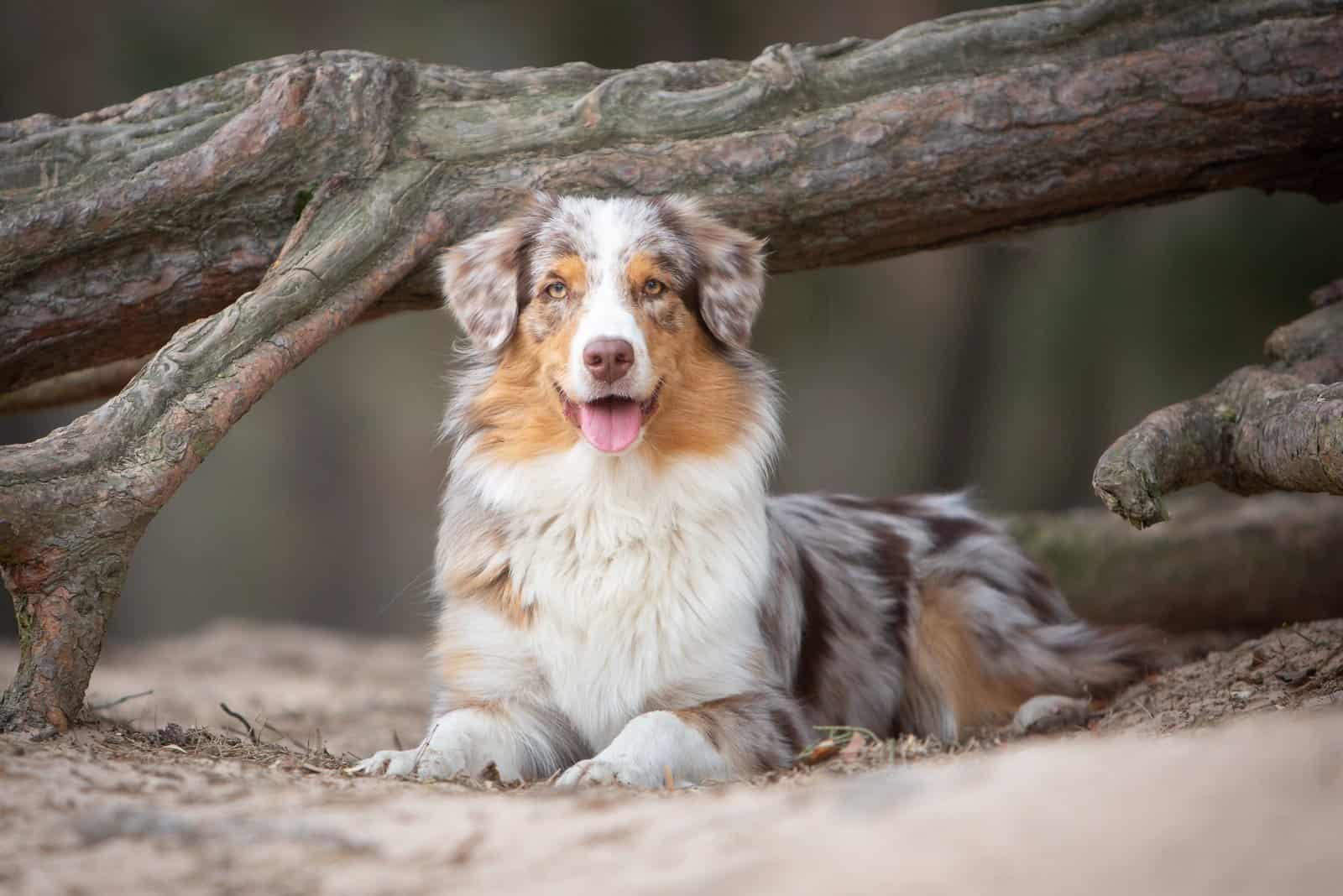Herding dogs are the all-time favorite human companions. What makes them so special among other dog breeds is their assertiveness, agility, and intelligence. What also makes herding dogs unique is their mesmerizing appearance.
The most unique-looking herding dog (in my opinion at least) is the Australian Shepherd. I mean, the Australian Shepherd’s coat colors make this dog breed the most colorful herding breed of dog out there. Another reason why I’m going crazy whenever I see an Australian Shepherd, is because of its sky-blue eyes.
But, today we are not going to talk about Australian Shepherd’s eye and coat colors. Today we want to find out how big an Australian shepherd can get.
How to figure out the real size of this medium-sized dog. We want to go further into details about Australian Shepherd’s puppy weight, height, and overall size. By using this Australian Shepherd growth chart we are easily going to figure out all of that.
Alongside estimated puppy sizes, this Australian Shepherd growth chart answers some of the most common questions prospective Australian shepherd owners often ask.
So, let’s jump right into it!
Australian Shepherd Puppy Growth Chart
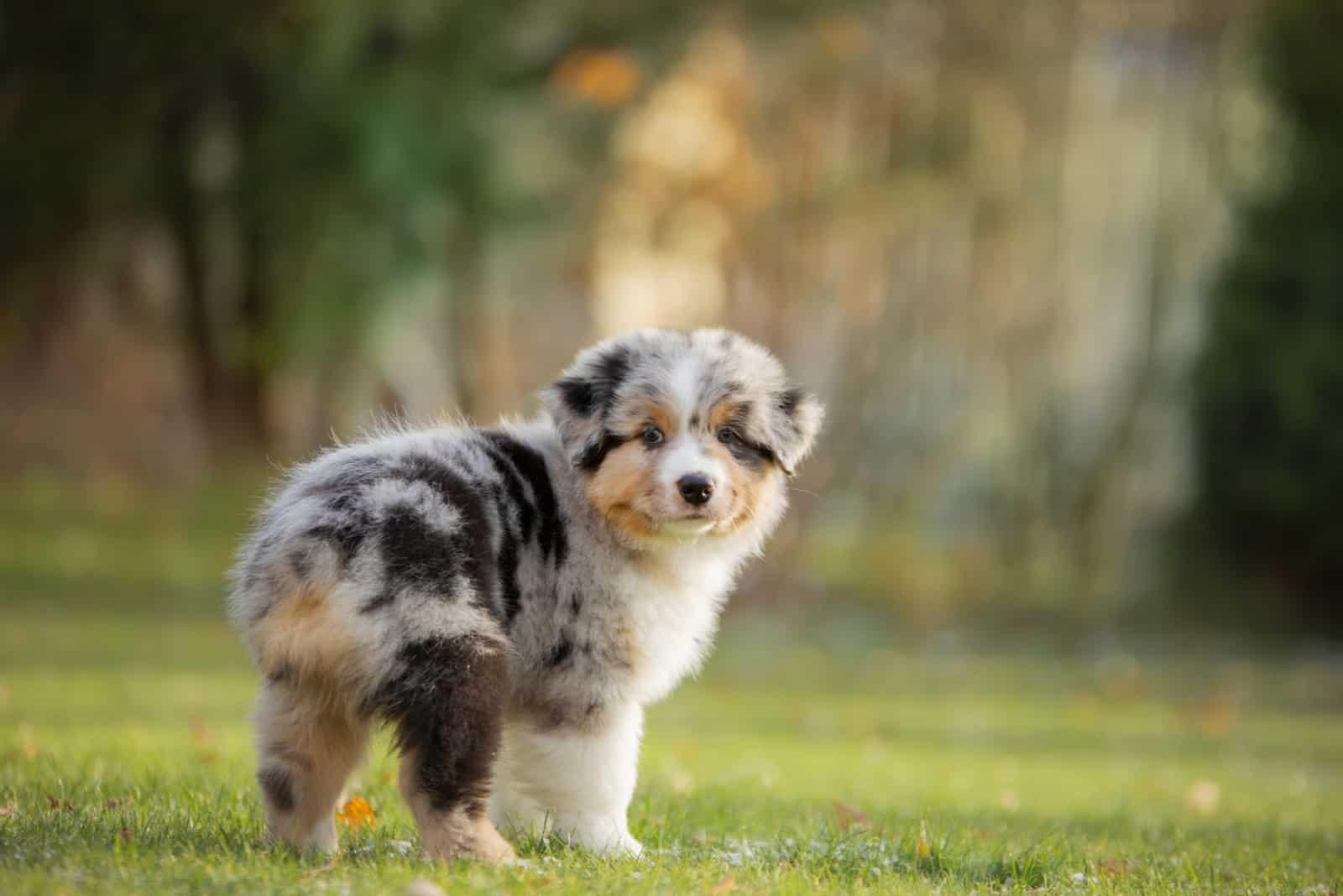
I think it’s a great idea to start off the Australian shepherd growth chart with an actual growth chart. This is an estimated overview of the Australian shepherd puppy growth size.
The table you see down below features the female and male Australian Shepherd puppies. That said, it shows the weight differences between two genders.
[table id=423 /]
Normally, female Australian Shepherds are smaller than male Australian Shepherds. But, that doesn’t mean that they are weaker nor less agile. Besides physical characteristics, male and female Australian Shepherds inherit different personality traits and behavior.
Australian Shepherd Puppy Weight Chart

Now that we know the approximate height of an Australian shepherd puppy, I’d like to talk more about its weight. The measurements are listed down below and they show the physiological weight of an Australian shepherd puppy during each month of its age.
[table id=424 /]
As the puppy grows, it gains more weight. Australian Shepherd’s weight is not only determined by dog food intake. Daily exercise and training plays a key role. In fact, more than 45% of the Aussie’s body weight is made of muscle mass. Now you’ve got a hint of what we will talk about later in this article.
Adult Male Australian Shepherd Growth Chart
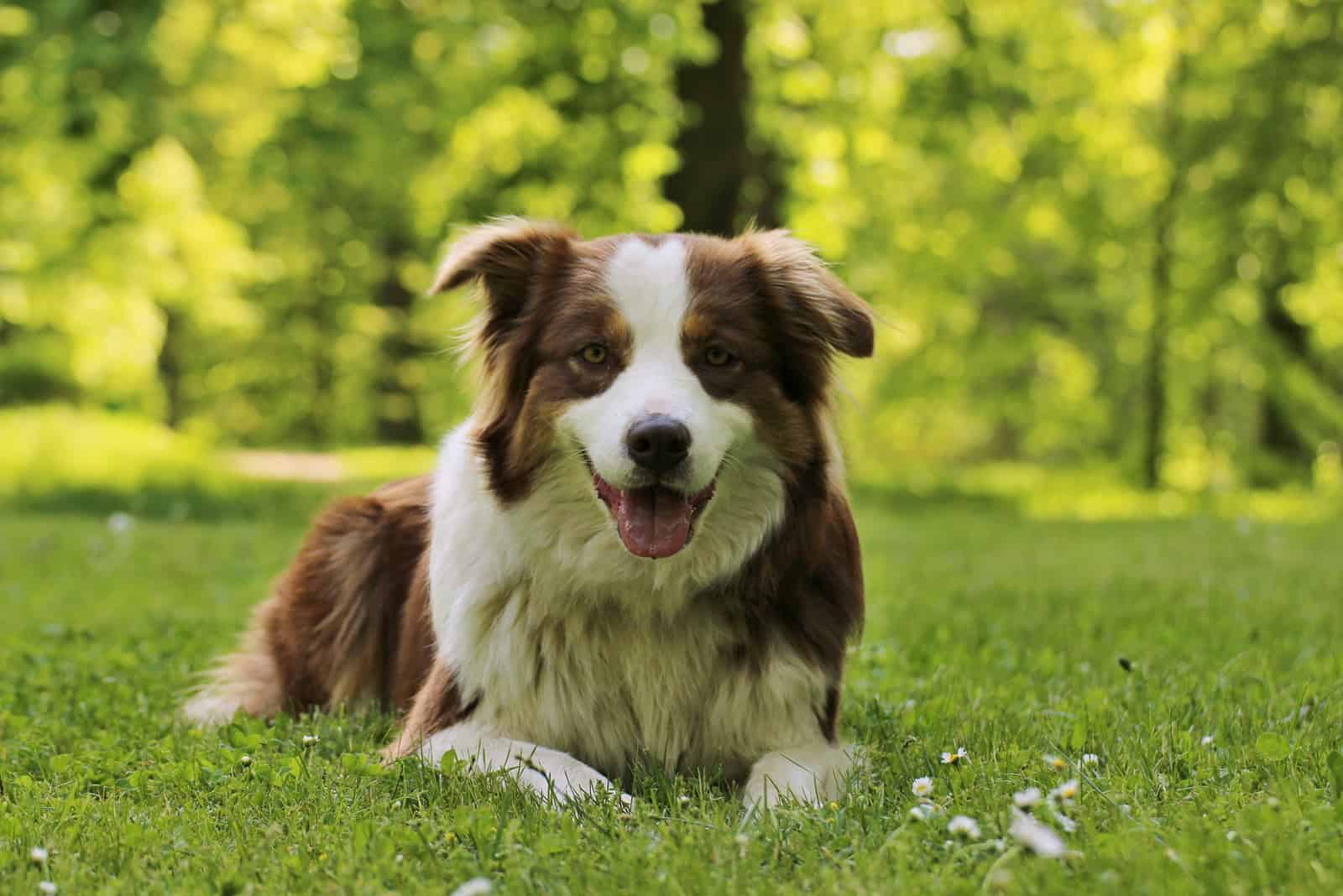
As we mentioned above, male Australian Shepherds are a bit larger than females. Although, you might not notice this physical trait unless you are comparing the two Australian Shepherds standing in front of you.
Alongside size, male Australian Shepherds have thicker and longer coats, especially around the ears and neck area. After all, they have to look fabulous in order to win an Australian Shepherd lady! Male Aussies are both heavier and taller than females. You might not believe this one, but male Australian Shepherds tend to be needier than their female counterparts!
Adult Female Australian Shepherd Growth Chart
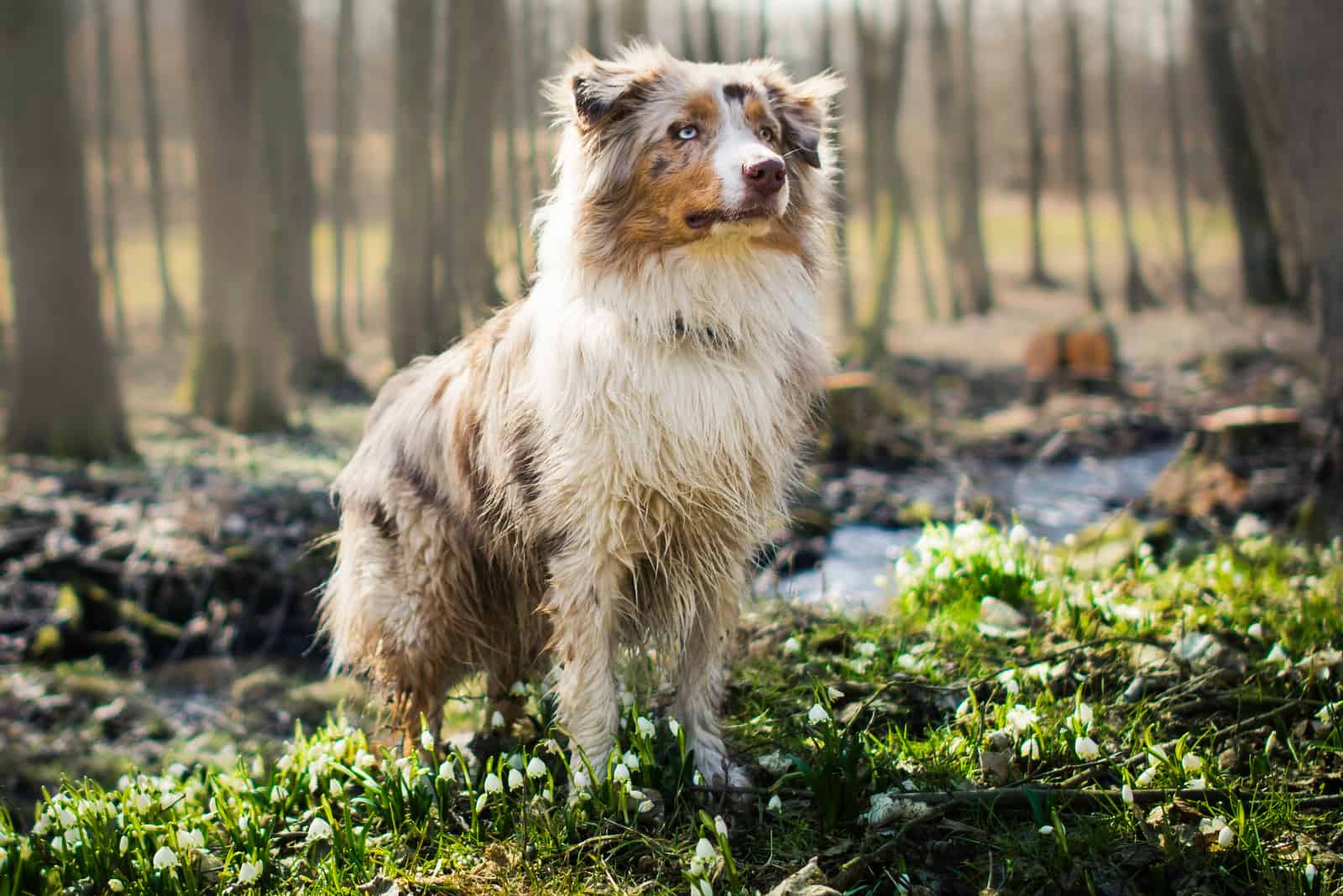
Some remarkable appearance traits of adult female Australian Shepherds are their shorter and less dense coats, as well as more feminine facial features.
There are periods in the Australian Shepherd growth chart where it seems that female puppies grow faster and bigger than males. But, male Aussie puppies quickly take back the growth lead.
When looking at the growth charts, it’s clear that female Australian Shepherds are a few inches shorter and a few pounds lighter than males.
But, if you ever see a pregnant female Australian Shepherd, you might think that it’s just a chubby male. What I want to say is that visual differences of this herding dog breed aren’t completely enhanced. If you’re curious whether the Aussie puppy is a male or a female, simply ask the owner or check under the dog’s tail!
Mini Australian Shepherd Growth Chart
Meet the mini version of the Aussie! Yes, Australian Shepherd breeders managed to develop a mini Aussie! However, the Miniature Australian Shepherd isn’t the same dog breed as the Australian Shepherd. And it isn’t the same as the Toy Australian Shepherd. But they are pretty similar. And if you are looking for an Australian Shepherd, but can’t keep it due to its size, you can choose its smaller cousin instead — the Mini Australian Shepherd!
The Mini Aussie reaches up to a maximum of 27 pounds. As for their height, Miniature Australian Shepherds usually reach between 14 and 17 inches, depending on the gender.
The Difference Between The Australian Shepherd And The American Shepherd
If you have read about the Australian Shepherd dog breed in general, you probably know that this dog is not actually Australian. Aussie’s heritage is linked to Spain, then Australia, and then the United States. But all of that doesn’t make it a Spanish Shepherd nor an American Shepherd.
Although similar in appearance, the American Shepherd is a different dog breed. Unlike the Miniature Australian Shepherd, the Miniature American Shepherd has been officially recognized by the American Kennel Club (AKC). Most people often confuse the two dog breeds because they look almost the same.
However, there are many physical characteristics that distinguish these two. For example, Mini American Shepherds are smaller than Australian Shepherds. They usually weigh between 20 and 40 pounds, and stand between 13 to 18 inches tall.
American Shepherds also have shorter lifespans and more inherited health conditions than the Australian Shepherds.
When Do Australian Shepherds Stop Growing?
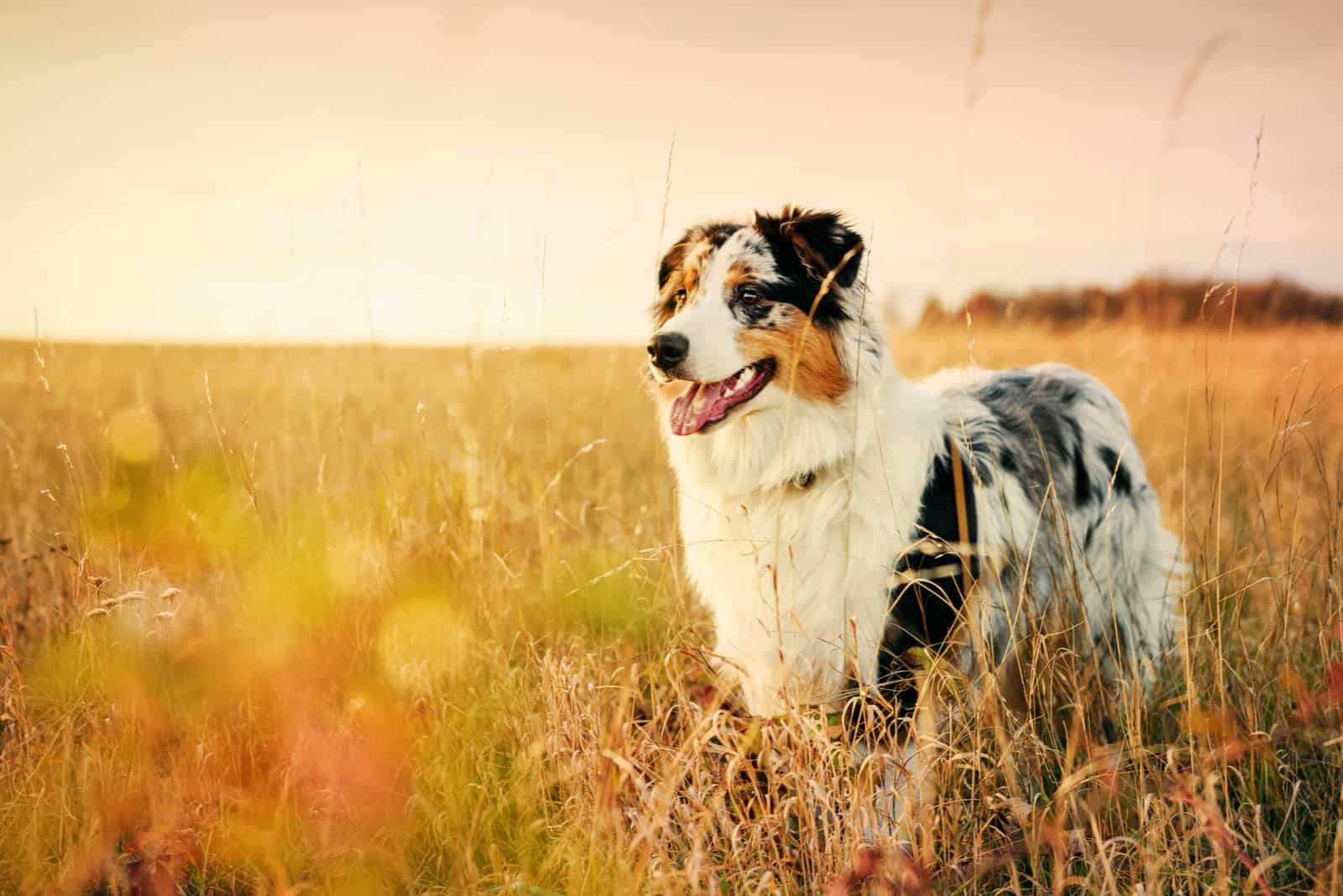
Every Australian Shepherd dog is a unique individual. So there is no exact time to specify when it will stop growing. Research shows that this herding dog breed stops growing in height when it reaches 12 months of age.
However, the Australian Shepherd dog doesn’t stop growing until 16 months of age. After the first 12 months you might not notice the ongoing growth, as your Aussie will probably remain the same height.
A full size male Australian Shepherd weighs 64 pounds, and its female counterpart weighs 45 pounds. Being a medium-sized dog, the average height of an Aussie dog is between 20 and 23 inches.
Its growth is determined by its sexual maturity, physiological development of bone and muscle tissue, as well as its behavior. The best way to find out whether your adult Australian Shepherd has stopped growing is to ask your veterinarian.
Australian Shepherd Growth Rate
The Australian Shepherd is a medium-sized dog. Unlike other herding and working dog breeds like the German Shepherd and the Collie, the Australian Shepherd is smaller in size.
Medium-sized dog breeds usually reach adult size between 12 and 16 months of age. Compared to large dogs, medium-sized dogs do not experience major growth spurts.
Australian Shepherds grow gradually. The period in which we notice that their size doubles is between eight and twelve weeks of age.
After that period, Australian Shepherd puppies gain 1 to 1.5 pounds per week. Depending on their metabolism, some puppies may put on up to two pounds per week.
Australian Shepherd Puppy Growth Stages
With all of these numbers around, it’s best to break the table in a few parts apart. We’re going to mention the growth stages of an Australian shepherd puppy.
Taking into consideration different time periods (weeks and months) that are crucial for Australian Shepherds puppies development. And, what I mean by development is not only physical growth, but also mental growth.
Let’s begin from the neonatal period, the birth.
From Birth To Four Weeks Of Age
Starting from day one, the Australian shepherd mother gives birth to a litter of 6 to 8 wonderful Aussie puppies.
At birth, Australian Shepherd puppies weigh only 1.5 to 2 ounces. Usually, some puppies are larger, and some are smaller. And, it’s completely normal to see differences in Aussie puppy size in each litter.
Why Nursing Is Important For Newborn Puppies
One of the most crucial moments for the newborn Australian shepherd puppy is beginning to nurse. This is why small puppies need their mothers the most. The first milk produced by an Australian Shepherd mother is called colostrum. This milky liquid must get into each puppy’s little stomach right after birth.
Why is it that important you ask? Well, newborn puppies don’t have a strong immune system so this milky substance acts as a protector of their fragile organisms. Colostrum is packed with immunoglobulins, vitamins, and proteins. So when a puppy drinks colostrum, it is almost guaranteed that it will grow into a healthy dog.
The first week of age is when things start to get going slowly. I mean, nothing in particular is happening yet. Except that the Aussie puppies are starting to gain their first pounds.
Week two is when Aussie puppies open their eyes! They weigh 2 to 2,5 ounces. This is the time where they first get to see the world around them, and everything changes. They become very curious, but are not quite sure how to use their tiny legs. So, they begin to learn how to walk.
For the first two weeks, the Aussie puppies mostly sleep, nurse, and dream. They roll around, pile up on one another, and even occasionally fight each other for food (mum’s milk).
The third and fourth week is where the Aussie pups begin to be more vocal, adventurous, and cocky. By now they already know how to walk and want to explore the environment.
Australian Shepherd Puppy Teething: From Three Weeks To Six Weeks
Aussie puppies start teething at three weeks of age. When your Aussie puppy starts teething it’s best to get it used to a quality chewing toy. I am putting a great emphasis on this because the Australian Shepherd is a herding dog.
Herding dogs have inherited this unique nibbling trait as they were born to assemble sheep and other livestock. So, Australian Shepherd puppies probably won’t stop biting you unless you teach them not to. Aussie puppies may also want to bite you as they walk by you.
This is what they were bred and taught to do. At the very beginning of breeding the Australian Shepherds, these dogs would nibble on the feet of livestock in order to get them moving. This way they would move the entire herd from one place to another.
So, in order for you to avoid being a sheep for an Aussie, just buy your puppy a good chew toy.
Oh, and if you have other animals within the household, they might also have a problem with Australian shepherd puppy’s teething.
Four Weeks To Eight Weeks
By the end of their first four weeks of age, the puppies are becoming quite active. They already know how to walk, talk, and act like little herding dogs.
It’s amazing to see how much the Aussie puppy’s growth progresses in the first four weeks of age. From four to eight weeks is another period of progression for a brave Aussie pup.
At around six weeks of age, Aussie puppies are naturally weaned by their mom, as their baby teeth have started growing. No more free food, now it’s time to buy some quality puppy food!
During this, as well as the upcoming period, Australian Shepherd puppies are restless — especially at night. But, don’t worry. This doesn’t last too long as the puppy’s biorhythm gradually develops.
Moving up to eight weeks of age, most Australian Shepherd puppies are ready to find new homes. Dog owners that are about to purchase an Aussie puppy will most likely get an eight week old pup.
So, what are the measurements for an 8 week old Aussie?
A healthy eight-week old Australian Shepherd puppy should weigh between four and eight pounds and stand between three to five inches in height.
During this period you notice how Aussie puppies interact with each other, bark, whine, run, and wag tails! They are also very loving of their owners and engage into conversation and playtime.
Take this opportunity to start socializing and training your Australian Shepherd puppy!
Four Months To Six Months
The Aussie puppy has become bigger. At four months of age, an Aussie puppy weighs between 32 and 23 pounds. But, they are still quite short, standing from 12 to 14 inches at withers.
Australian Shepherd puppies are high-energy puppies, especially during the first year of their life. Perhaps the period of four to six months is when they get the puppy zoomies.
Sometimes, Australian Shepherd puppy zoomies can be hard to handle. But, it is important to stop your four-month old Aussie puppy from overrunning and eventually hurting itself. During this period, the puppy’s bones have not yet developed, and there is a lot of room for early health conditions to occur.
Six months of age marks the half of your Aussie’s adult size.
How big is a 6 month old Australian shepherd?
A six-month old Australian Shepherd should weigh between 45 and 33 pounds. It has also grown a few inches taller. At six months of age, an Aussie puppy is 15 to 17 inches tall.
Another important thing that happens during this period is that the Aussie puppy hits puberty. Now, dog owners have to deal with that behavior.
Neutering a puppy can be done by the end of the sixth month. As for spaying, female Aussie puppies should not be spayed until they reach twelve months of age.
Eight Months To Twelve Months
We are almost there! The Aussie puppies have grown so much in size. Their bones became heavier, their bodies more muscular, and their minds wiser. Well, I’m not so sure about the last part.
An eight month old Aussie puppy now weighs 47 to 58 pounds and measures between 17 to 19 inches at withers. The puppy growth rate has declined by now, but the Aussie still keeps growing.
The adolescent Aussie pup is on its way to reach sexual maturity. Usually, sexual maturity in dogs is reached between seven to twelve months of age. But, for our Australian Shepherd, sexual maturity is described between ten and eleven months of age.
Expect a female Aussie to get in heat. Look out for your male Aussie’s signs that it wants to mate. The last thing you would want is for your beloved Aussie to run away in search of a partner.
At eleven months of age, an Australian Shepherd stands from 20 to 22 inches in height, and weighs between 43 and 67 pounds.
Adult Size
The Australian Shepherd is not a large dog, nor is it a small dog. So its adult size should be that of a medium-sized dog.
What is the average weight of an adult Australian Shepherd?
Its adult weight and height depends on the way the Aussie has been brought up. The healthy adult size of an Australian Shepherd is between 54 and 68 pounds. Female dogs are usually a few pounds lighter. Male dogs reach up to 23 inches in height, whereas the female Aussies stand around 20 inches tall.
Although your Aussie puppy is now all grown up, it is still your little, high-energy baby that loves to cuddle and play!
How Long Until The Australian Shepherd Is Full Grown?
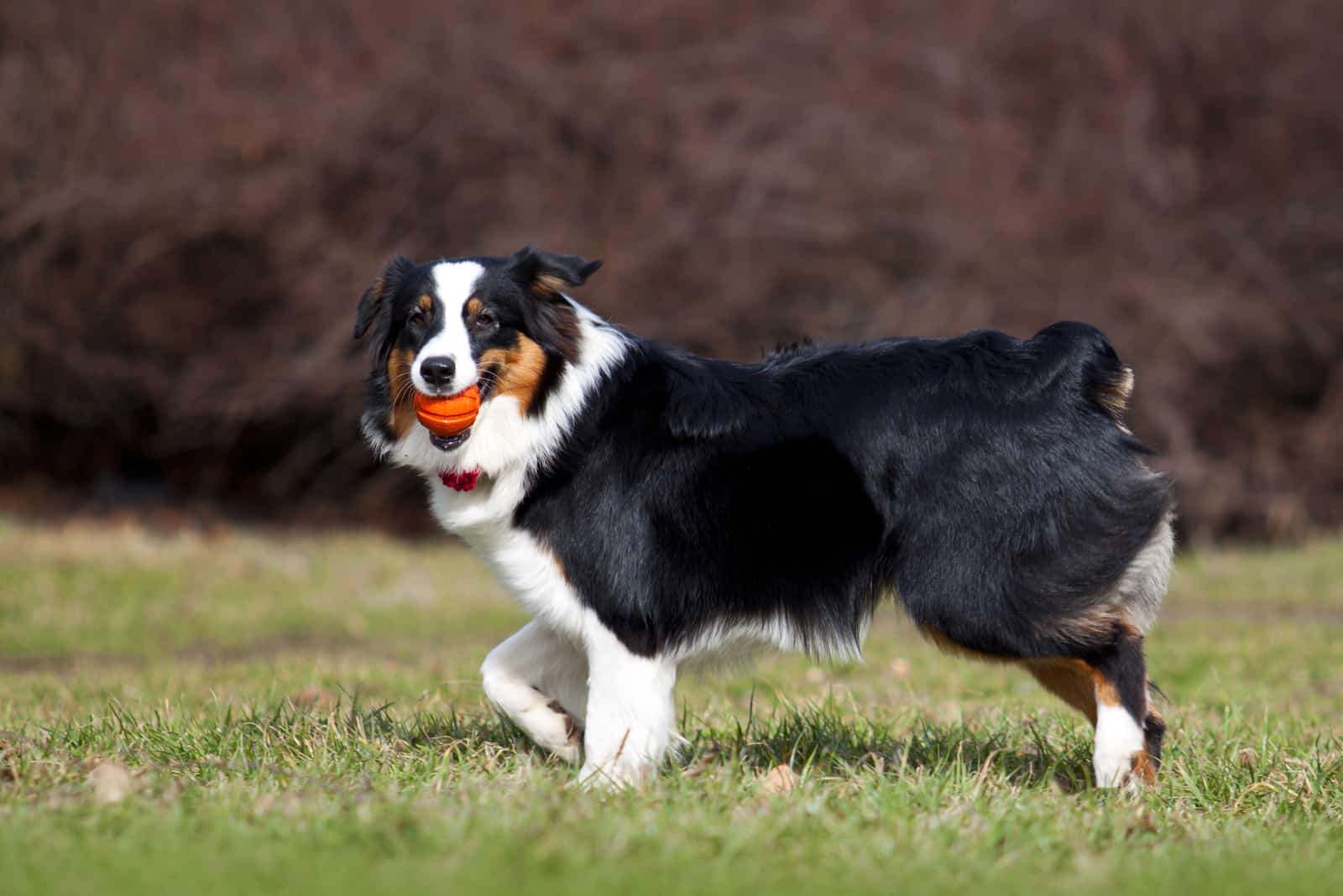
In some cases, it can take over 16 months for an Australian Shepherd to fully grow. Normally, the Australian Shepherd dog is fully grown between twelve and 16 months of age.
By fully grown I mean mostly physically. Most dogs continue to behave like little puppies even at adult age. If the Aussie reaches adult size at 16 months of age, then what is the average weight of a 3 year old Aussie?
Well, a healthy 3 year old Aussie should weigh between 56 and 69 pounds. With an accent on the word “healthy”. Let’s find out more about an Australian Shepherd’s healthy and unhealthy weight.
Is My Australian Shepherd Overweight?
The answer to this question can be found by looking at the Australian Shepherd growth chart. It can also be found by looking at your dog food supplies.
If you notice that your Aussie is a bit chubby, I am sorry to inform you, but it is time to cut the snacks. An overweight Australian Shepherd is more wide than it is tall. Don’t let its long coat fool you into thinking it’s only fur, when there is over 80 pounds underneath it.
Do not let a few extra pounds on your Aussie dog turn into obesity. Trust me, there is a thin line between an overweight dog and an obese dog. Dog obesity is quite common in the United States, and it’s not cute at all.
Avoid feeding your dog bagels, bread, and similar human foods. Also avoid processed, spicy, salty, sour, and sweet food. These are only examples, but you can easily find information about what foods are allowed for dogs to eat, and foods dogs shouldn’t eat. So, make sure to do your research.
If it’s not food that is causing your dog to become overweight, there might be some underlying health conditions that require a vet check-up.
Putting your overweight Australian Shepherd on a healthy, balanced diet is a good way to start. But, before changing its routine, consult your veterinarian or your veterinary nutritionist.
Is My Australian Shepherd Underweight?
As serious as excessive weight on your dog is, insufficient weight is equally alarming.
An overweight Aussie looks like an inflated balloon. An underweight Aussie looks like a deflated balloon. There are many reasons why your Aussie would be underweight. Insufficient protein intake, low quality dog food, unhealthy life habits, as well as underlying health conditions could be all to blame.
An underweight Australian Shepherd is lethargic, weak, fragile and extremely thin. Its once rich coat is dull, dry, and sparse.
To avoid your Aussie from becoming underweight, make sure to have a proper meal and exercise schedule. Carefully choose high-quality dog food for your pooch and seek advice from a professional veterinarian.
How To Measure Your Australian Shepherd Dog

Measuring an Australian Shepherd dog is as easy as measuring yourself. To measure its weight, simply put your Aussie on a measuring scale.
You can use your own scale for this, but there are also pet measuring scales. Both are good for measuring the weight of your Australian Shepherd dog.
As for height, get your measuring tape out and start from the Aussie’s paws. Keep your dog in a standing position. Spread the measuring tape up to its withers and read the result. Yes, it is that easy!
If your Aussie is completely uncooperative and you just can’t get it to stand still, search for weight calculators online. A weight calculator can help you calculate current dog weight, as well as help you predict the weight of an adult dog.
I personally find it fun to play around with this handy calculating tool. It’s easier than doing math on your own!
Factors Affecting Australian Shepherd Puppy Growth

Puppies don’t just grow out of the water, right? There are a lot of outside factors that aid puppy development. But, there are also factors that prevent puppies from growing.
Let’s find out which factors affect the Australian Shepherd puppy’s growth.
Genetics
Genetics are always the main culprit of any health condition and the overall state of a living being. In dogs, genetics play an important role. Perhaps it is more important than in humans.
Dog breeders usually mix and match dogs with different genetic pictures in order to achieve either a new trait, or to enhance an existing trait. This is good and bad at the same time.
Sometimes, breeders make mistakes and develop unhealthy dog breeds. By crossing and breeding such dogs, low-quality genes are passed on new puppy generations.
The importance of right genetics lies right here. A healthy puppy that is growing at a normal pace is a puppy with good genetics. It simply has a good predisposition to grow up healthy.
Dog breeders also often hit the “dog jackpot” in creating amazing mixed breeds with great characteristics. Mixing similar types of dogs usually results in excellent genetic traits. When two herding dog breeds like the Australian Shepherd and German Shepherd are crossed, this combination makes a remarkable hybrid with a healthy background.
Diet
You can’t grow a plant unless you water it, am I right? Well, you can’t grow an Aussie puppy unless you feed it. And I mean feed it properly.
High-quality dog food doesn’t always have to be expensive. There are many dog food brands out there and you will most likely find a brand that suits your wallet and your dog’s stomach.
Make a plan of when and how much you’re going to feed your Aussie. If you are a first time dog owner, get yourself a notebook and write down your dog’s feeding schedule.
A balanced diet along with regular exercise is crucial for your Australian Shepherd’s growth. The nutrients from food will feed every cell of your dog’s body and it will soon grow into a healthy adult dog. Our Australian Shepherd feeding chart might help you in understanding of quality nutrition for your Aussie.
Exercise
Australian Shepherds love to run! This is an amazing trait of these high-energy dogs. They never seem to rest.
Although it’s important to exercise them daily, make sure not to overdo it. Exercise is great for muscle development and bone strengthening, making the Aussie puppy grow strong and healthy.
Exercise is also great for mental development and socialization.
Australian Shepherd Health Problems
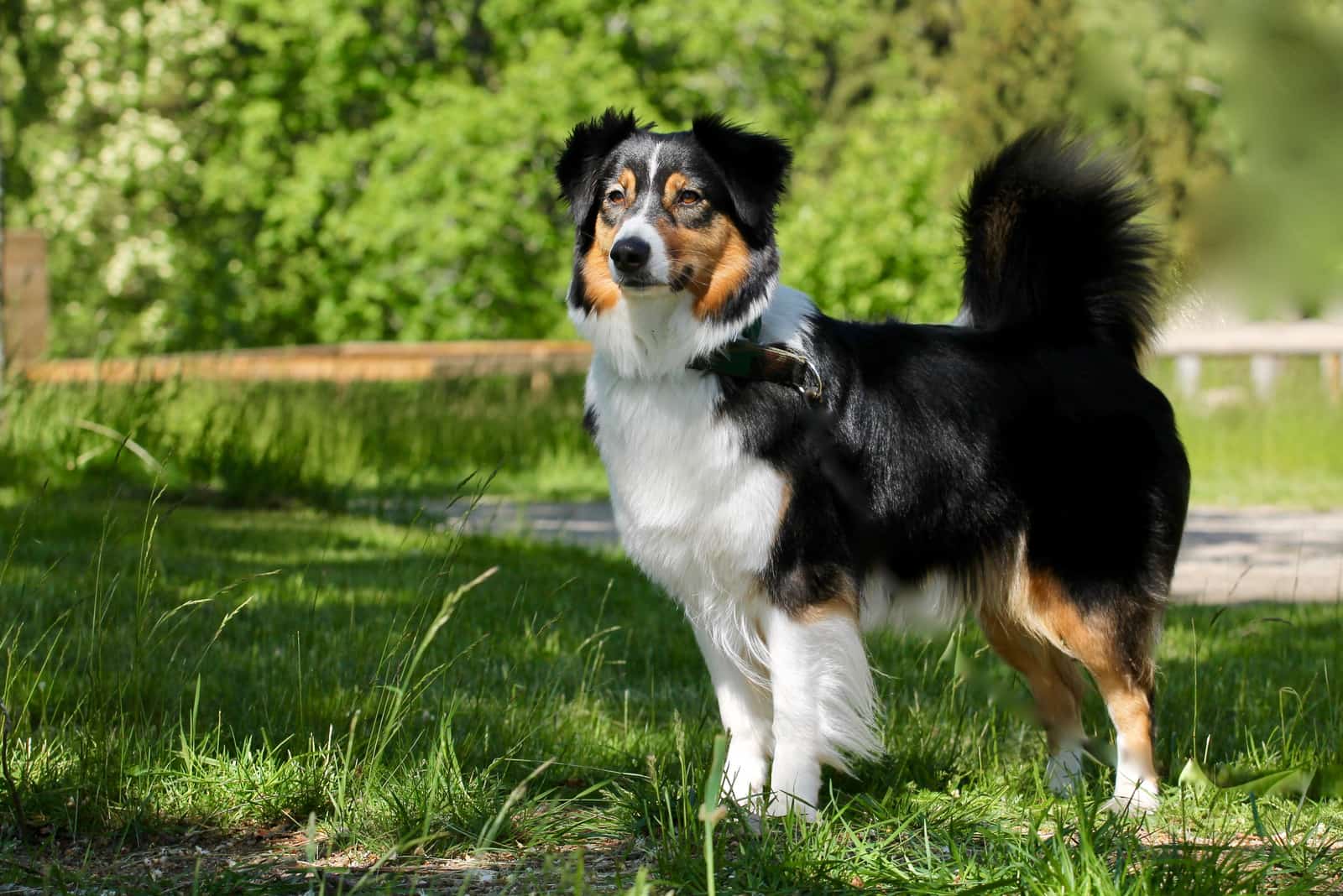
The Australian Shepherd is a relatively healthy dog breed. But it can inherit some health problems like epilepsy, hip and elbow dysplasia, as well as cataracts.
Most health problems in Australian Shepherds aren’t linked to their size, but to their genetics.
Health problems may occur early in life, but they can also develop once the Aussie has stopped growing. You can prevent many health conditions from occurring by taking care of your Aussie and frequently doing health check-ups.
By taking care of its health, you will most likely prolong the Aussie’s lifespan. On average, a healthy Australian Shepherd’s lifespan is from 13 to 15 years.
In Conclusion
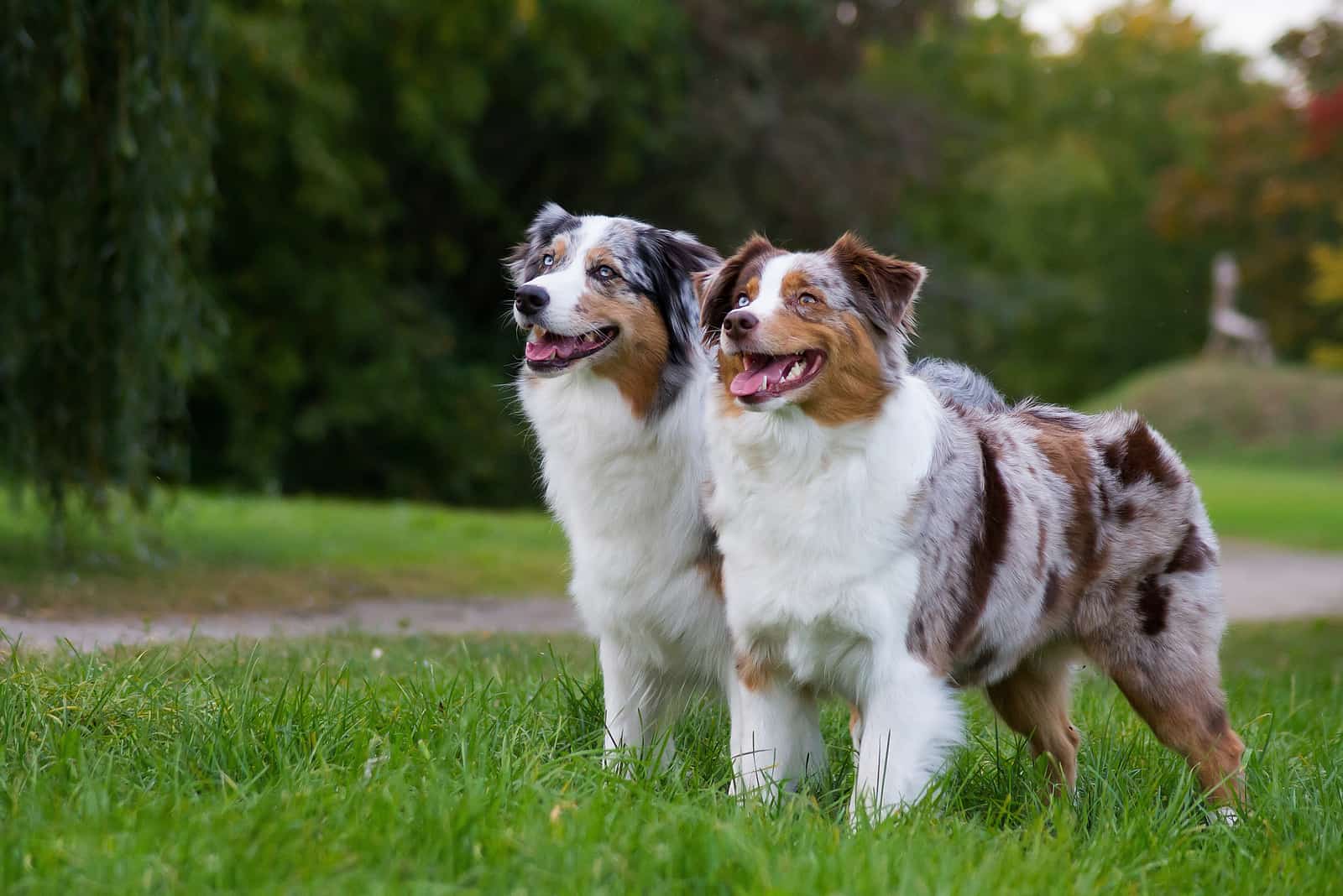
Australian Shepherds are amazing herding and working dogs. They are high-energy fluffballs that are fun to be around with. Aussies are especially fun during their growth period. They’re clumsy, talkative, and very attentive.
Due to their kind and fun-loving nature, Australian Shepherds get along well with kids and other animals. But, only if socialized from an early age.
Understanding the Australian Shepherd growth chart is important for future and current dog owners. Not only are they getting to know the puppy’s weight and height, but they are also learning more about everything that happens during puppyhood.
Related Content
• Blue Heeler Growth Chart – How Big Will Your Blue Heeler Get?
• Bernedoodle Growth Chart: How Big Will My Bernedoodle Get?
• Cavapoo Growth Chart: A Complete Guide To The Cavapoo Dog Size
